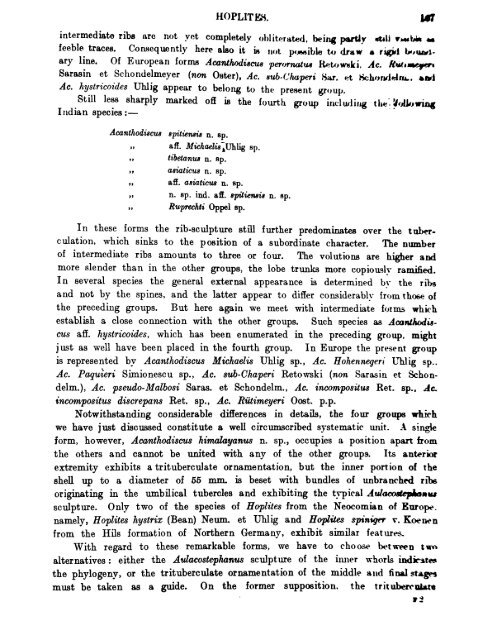Ser. XV. HIMALAYAN FOSSILS, Vol. IV. THE FAUNA OF THE SPITI ...
Ser. XV. HIMALAYAN FOSSILS, Vol. IV. THE FAUNA OF THE SPITI ...
Ser. XV. HIMALAYAN FOSSILS, Vol. IV. THE FAUNA OF THE SPITI ...
You also want an ePaper? Increase the reach of your titles
YUMPU automatically turns print PDFs into web optimized ePapers that Google loves.
HOPLITES. Jtf!<br />
intermediate ribs are not yet completely obliterated, being partly «tdi *»<br />
feeble traces. Consequently here also it is not po*»ible to draw a ryfirt<br />
ary line. Of European forms Acanthodiscus perwnatus Retownki, Ac. Ruttmefer*<br />
Sarasin et Schondelmeyer (non Oster), Ac. sub-Chaperi Sar. et Hckamldiu..<br />
Ac. hystricoides Uhlig appear to belong to the present group.<br />
Still less sharply marked off is the fourth group including the, {following<br />
Indian species:—<br />
Acanthodiscus spitiensis n. sp.<br />
» aff. Michaelis^JhMg sp.<br />
„ tibetanus u. sp.<br />
i, asiaticus n. sp.<br />
» aff. asiaticus n. sp.<br />
» n. sp. ind. aff. spitiensis n. ap.<br />
„ Ruprechti Oppel sp.<br />
In these forms the rib-sculpture still further predominates over the tuber-<br />
culatum, which sinks to the position of a subordinate character. The number<br />
of intermediate ribs amounts to three or four. The volutions are higher and<br />
more slender than in the other groups, the lobe trunks more copiously ramified.<br />
In several species the general external appearance is determined bv the ribs<br />
and not by the spines, and the latter appear to differ considerablv from those of<br />
the preceding groups. But here again we meet with intermediate forms which<br />
establish a close connection with the other groups. Such species as Acanthodis-<br />
cus aff. hystricoides, which has been enumerated in the preceding group, might<br />
just as well have been placed in the fourth group. In Europe the present group<br />
is represented by Acanthodiscus Michaelis Uhlig sp., Ac. Hohennegeri Uhlig sp..<br />
Ac. Paquieri Simionescu sp., Ac. svb-Chaperi Retowski (non Sarasin et Schon-<br />
delm.), Ac. pseudo-Malbosi Saras, et Schondelm., Ac. incompositus Ret. sp., Ac.<br />
incompositus discrepans Ret. sp., Ac. Riitimeyeri Oost. p.p.<br />
Notwithstanding considerable differences in details, the four groups which<br />
we have just discussed constitute a well circumscribed systematic unit. A single<br />
form, however, Acanthodiscus himalayanus n. sp., occupies a position apart from<br />
the others and cannot be united with any of the other groups. Its anterior<br />
extremity exhibits a trituberculate ornamentation, but the inner portion of the<br />
shell up to a diameter of 56 mm. is beset with bundles of unbranched ribs<br />
originating in the umbilical tubercles and exhibiting the tvpical Aulacostephanus<br />
sculpture. Only two of the species of Hoplites from the Neocomian of Europe,<br />
namely, Hoplites hystrix (Bean) Neum. et Uhlig and Hoplites spiniger v. Koenen<br />
from the Hils formation of Northern Germany, exhibit similar features.<br />
With regard to these remarkable forms, we have to choose between twv»<br />
alternatives: either the Aulacostephanus sculpture of the inner whorls indicates<br />
the phylogenv, or the trituberculate ornamentation of the middle and final stages<br />
must be taken as a guide. On the former supposition, the trituberrulare<br />
rj

















